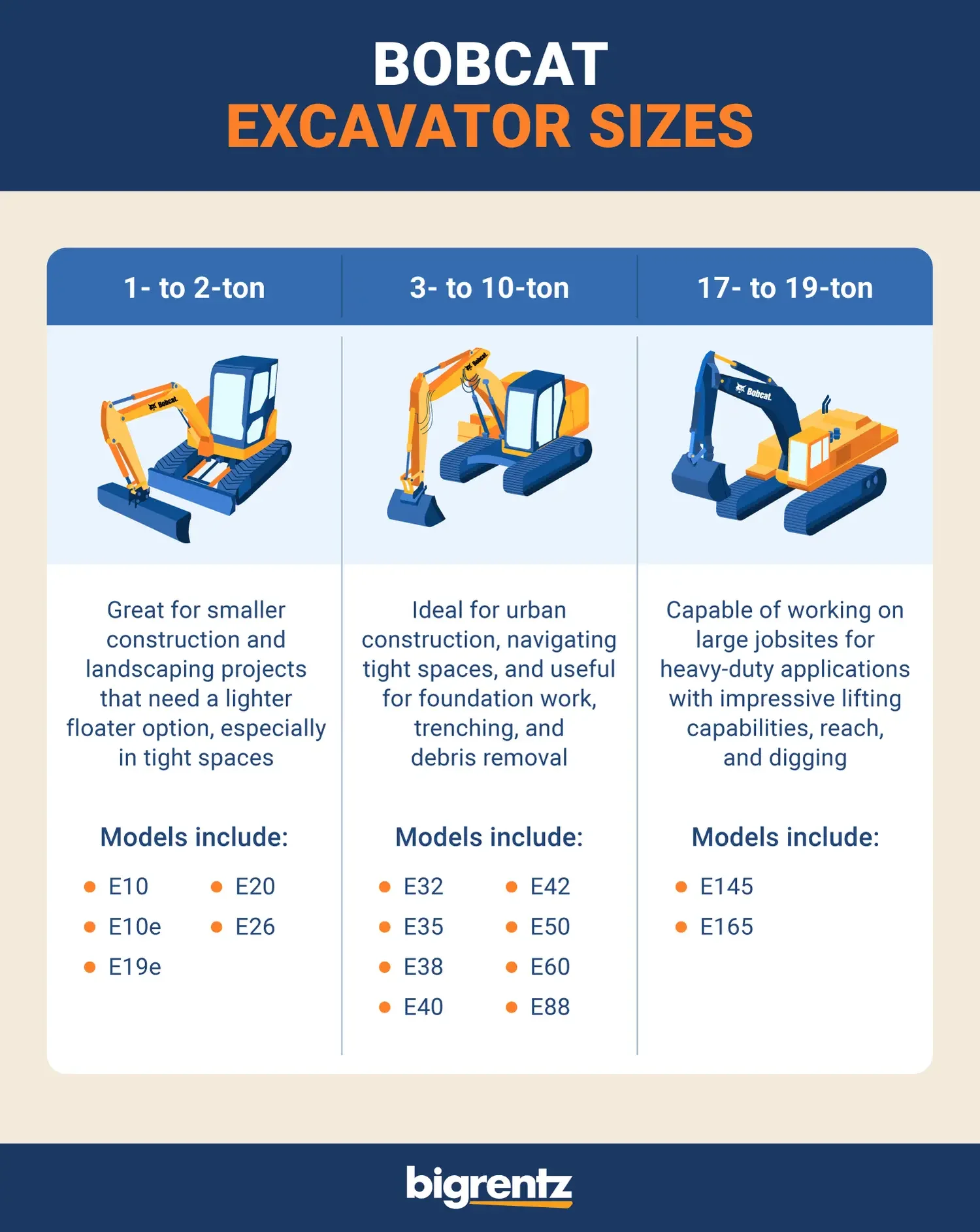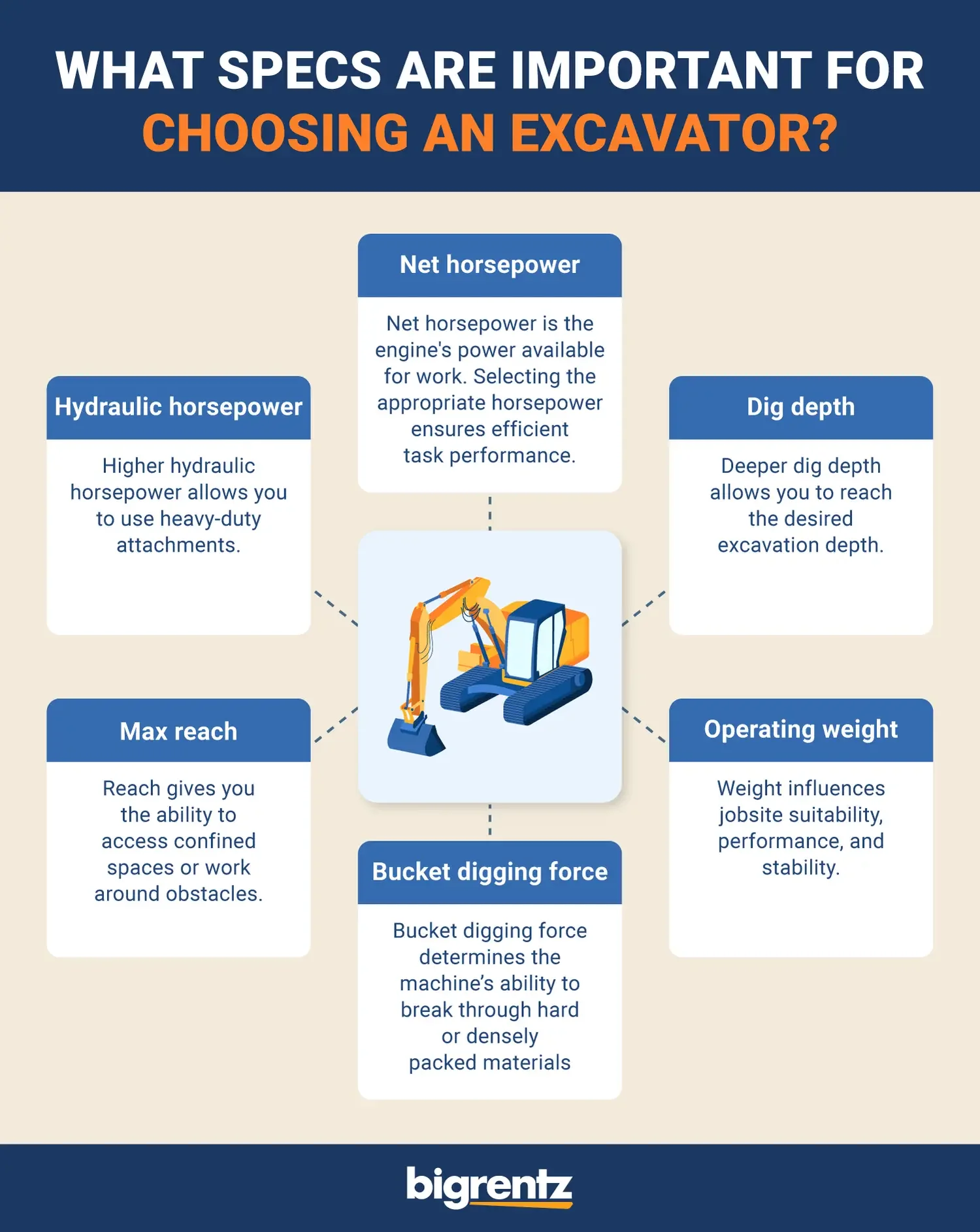Keywords: excavator rock bucket, excavator sizes, walk behind mini excavator
excavator rock bucket
case excavator sizes
walk behind mini excavator
Bobcat began mass-producing compact construction equipment in the late 1950s and came out with their first compact excavator in the late 1990s. Since, they’ve continued to develop innovative equipment like the first electric mini excavator (E10e), introduced in 2019.
Integrating even more easy-to-use features, the R2-Series of excavators, released in 2020, come with touch displays, low-effort joysticks, and depth-check accessory kits.
Bobcat excavators range from compact machines, for easier maneuverability and versatility, to large models, designed for more power and greater dig depth. In this post, we go over the range of Bobcat excavators and their specs to help you pick the best machine for your job.
Explore All Excavators
What Are the Excavator Size Categories?
Excavators come in a range of size classes. Generally, they’re classified as either compact, or mini, standard, or large. Bobcat categorizes excavator sizes as compact or large, according to these standards:
- Bobcat compact excavators (or mini): This type of excavator is typically less than 10 tons. It’s used in small jobs that require more maneuverability and versatility, like backfilling when excavating utility trenches.
- Bobcat large excavators (or standard): Large excavators fall between 10 and 45 tons. They’re best for projects that require heavy lifting and powerful digging capabilities, like heavy-duty construction or demolition.

Bobcat Excavator Sizes and Specs
Here’s how Bobcat excavator models break down in terms of their key specs: horsepower, max dig depth, max reach, operating weight, and bucket digging force.
Less Than 10-Ton Compact Excavators
Compact excavators are generally less than 10 tons in size. But, within that bracket, there are different types of compact or mini excavators.
1- to 2-Ton Excavators (2,000 to 6,000 lb)
Models include: E10, E10e, E19e, E20, E26
These are the smallest sized excavators. They’re great for modest construction and landscaping projects due to their blade float and tail swing ranges, allowing them to be adjusted to handle light digging work and tight spaces. They offer little ground distance and are easy to transport from jobsite to jobsite.
Typical tasks for this size excavator range from shallow trenching and digging to light grading and demolition.
Bobcat’s E10e and E19e are revolutionary lithium-powered machines that have the same capabilities as their fuel-run counterparts. Plus, they have a constant torque curve, a feature that’s unique to electric models.
3- to 10-Ton Excavators
Models include: E32, E35 (25 hp and 33 hp), E38, E40, E42, E50, E55, E60, E88
Excavators in the 3- to 10-ton range can trench, grade, dig foundations, prep worksites, and meet material handling needs. Compact excavators weighing 5 tons are a popular choice for residential digs close to existing walls or foundations. Larger 6- to 10-ton models work well for backfilling and demolition.
These machines are a balance between power and agility, making them extremely versatile. They can tackle substantial digging tasks for mid-sized projects.
Bobcat excavators that range from 3 to 10 tons come with low-effort joysticks, Pro Clamp and Hydraulic X-Change options, depth-check systems, touch displays (some models), and configurable arms. These features not only give operators more precise control and visibility into how these machines function, but also makes their functionality on a jobsite highly adjustable in terms of power and force.
The R2-Series got an upgrade in 2021, with the introduction of three new excavator models—the E32, E35 25hp and E35 33hp—built to handle utility, residential, and landscaping projects with lift capacity improvements and advanced hydraulics.
Bobcat mini excavators, including the E35 and E48, are designed with digging arms that are compact and positioned near the machine, which produces superior breakout force compared to competitors like Kubota. The Bobcat E50‘s distinct in-track swing frame lets you excavate alongside a wall and pivot towards your soil mound without colliding with the adjacent structure.
17- to 19-Ton Large Excavators
Models include: E145, E165
Large excavators are capable of working on heavy-duty applications. They have impressive lifting capabilities, reach, and hydraulic performance. They provide power and precision for large-scale earthmoving projects, like mining, highway construction, and major infrastructure development, and have the strength and stability to handle heavy digging.
Bobcat only has two excavators that fall into the “large” category. Both machines have four power modes, making them adaptable and efficient.
- Power+ mode: This is peak performance for the excavator, its top speed and highest level of force, helping you in the most demanding applications.
- Power mode: This mode provides enough power for difficult digging, quick loading, and heavy-lifting applications at a more sustainable level.
- Standard power mode: This mode offers the level of power required to perform most basic or routine digging, lifting, and grading tasks.
- Economy mode: Designed to optimize fuel economy, this mode saves power during applications like fine digging or grading, when you need more precision and less force.
What Specs Are Important for Choosing an Excavator?
When choosing which excavator is right for your job, it’s important to keep the following specs in mind:
- Hydraulic and net horsepower
- Dig depth
- Max reach
- Operating weight
- Bucket digging force

While these may not be the only specs to consider, they are some of the most important—they specifically relate to how your excavator functions on the job. You can compare these against your project requirements.
For example, mini excavators are best for smaller applications like sewer repairs and water line installations. Large excavators, by contrast, work best in applications like heavy-duty construction and demolition. Similarly, the type of job or jobsite will also impact what excavator size and model you need.
Here’s a more in-depth description of each of these specs:
- Hydraulic horsepower: Hydraulic horsepower tells you how efficiently power can be transferred to the excavator attachments, which impacts overall performance. The higher flow hydraulic horsepower you have, the wider range of attachments you can use and at a more powerful pace.
- Net horsepower: Net horsepower gives you a realistic sense of usable power, taking inefficiencies into account. If you’re working in a heavy-duty application with deep or heavy digging, you’ll need a high net horsepower. If you have a small residential job that requires light digging, a lower net horsepower is enough for the job.
- Dig depth: This is the maximum depth an excavator can dig below ground. In most cases, dig depth is the primary spec to consider, since excavators are most often bought or rented for digging applications. Heavier excavators can typically dig deeper than compact equipment, so you might opt for a larger machine if your job requires heavy-duty trenching or a similar application.
- Max reach: This is the maximum distance an excavator’s arm can reach with its arm extended fully at ground level. If your jobsite is large or you need your excavator to work at height or depth, like in certain construction or demolition applications, you’ll want an excavator with either a longer extendable arm or versatile arm configurations that increase its maximum reach.
- Operating weight: An excavator’s operating weight refers to how much it weighs during use, including how much its bucket can hold. Operating weight influences some of its other specs—as mentioned above, heavier machines can typically dig much deeper than lighter ones. Higher operating weights generally correspond to excavator models with more power and force.
- Breakout force: Breakout force is the maximum force the bucket can exert to break through and lift material from the ground. If your jobsite has more difficult terrain, you’ll need a machine with more bucket digging force to dig and excavate the material.
How to Choose the Right Excavator for the Job
Choosing the right excavator for your job comes down to what you need to accomplish. Here are some factors to keep in mind when comparing Bobcat equipment models:
- Dig depth: This is typically the most important factor in choosing an excavator. Make sure your machine has the capacity to not only dig to the depth you need, but to also overcome enough digging resistance to effectively break through your work area surface.
- Jobsite requirements: What are the needs of the job? What’s the terrain like? If you need to excavate a small or narrow area without much depth, a mini excavator should do the trick. If you need more reach and dig depth, you’ll probably want a bigger machine.
- Capacity: Similarly, think about the capacity you need for the job. How deep does the excavator need to dig? How much material do you need it to lift, hold, or transport?
- Size: Make sure the excavator you choose fits in your work area. Typically, the larger the jobsite or more heavy-duty the application is, the bigger your machine should be.
- Power: If you need a lot of power and force, opt for a bigger machine. Heavier excavators can typically provide more in terms of breakout force, dig depth, and horsepower. For finer and more precise work, it’s better to go with a smaller machine.
- Tail swing: If you’re working in a tight space, you’ll want an excavator with a narrower tail swing. Typically, mini excavators have the narrowest tail swing range, making them better for work in areas like this.
- Reach: How deep or high does your excavator need to reach? Opting for a vehicle with better arm extension, or arm configurations for a broader range, makes it possible to work at a wider variety of depths and heights.
- Dump height: If you need to transport materials for hauling, dump height, the maximum height at which an excavator can lift and dump a load, is very important. You need to make sure your excavator can safely clear the sides of your dump truck. If your job involves moving material around the site without much dumping and hauling, you might get away with a lower dump height capacity.
Explore All Excavators
Ready to Rent an Excavator?
If you’re looking for an excavator to rent, you’ve come to the right place. Whether you’re working on a small or large project, BigRentz has you covered. With a wide variety of different brands and excavator sizes, we have the equipment to meet all your project and jobsite needs.